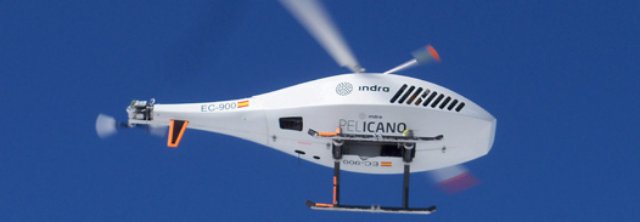made a flight demo of two of its unmanned aircraft – Mantis plane and the Pelican helicopter – at Villamartin aerodrome (Cadiz, Spain) during the European Robotics Week.
The Mantis is the smallest model (2,10 meter wing) of the family of UAS developed by the company. The system, ready to enter service, can be easy transported and operated by one or two people. A system of this type facilitates observation of movement in an operation range of around 30 kilometres.
The vehicle made an autonomous flight in accordance with a pre established flight plan and explored the area with a gyroestabilized electroptical camera which submitted images in real time. From the ground control station, the operators followed the flight and received the images. The system is under customisation to incorporate a laser-accuracy landing system.
The company also demonstrated the capacities of Pelican, a system conceived for maritime surveillance, which will be ready to enter service by early 2012. The flight was autonomous from beginning to end; the pilot did not intervene in take-off, flight and landing. The system behaved according to a pre-established plan including manoeuvres at different speeds.
Pelican is a rotary wing UAS prepared to embark on a military vessel. The system is in the last development phase and during the test period Indra managed to configure it in such a way that the engine can use heavy fuel oil – non flammable – as it is an elementary requirement to go onboard a military vessel.
Indra also carried out different tests with the electro optical system and has obtained high-definition imaging from great height and counter measured vibrations. The system with a top 50-kg payload can also carry other type of sensors such as electronic intelligence , CBRN or radars. The information received is transmitted in real time to the helicopter’s control station.
The Pelican system, with 6-hour autonomy, is built on the APID60 platform of Swedish company Cybaero. It can engage in different sorts of missions for instance: protection of bases and critical infrastructures, intelligence gathering, convoy protection, border surveillance, emergency management (forest fires, floods, technology disasters, etc.) and search and rescue on the coastal zone. It is also designed to patrol in the open sea, a very effective aspect in the struggle against piracy.
The European Robotics Week took place from the 28 of November to the 4 of December. The event was fostered by EUnited in Europe and it aims to popularise robotics and promote associated activities in the continent at all levels.
Among the events celebrated all over Spain Indra participated in the first workshop dedicated to investigation, development and education on Unmanned Air Systems (UAS) organised by FADA-CATEC/ University of Seville. At the event more than 50 articles elaborated by researches of nine countries were presented and several flight demos were made.
Indra was one of the pioneering companies in the development of these systems and has led along with Cassidian the startup of the first tactical UAV system which the Spanish Army has used in a real scenario in Afghanistan.
Source: Press Release

